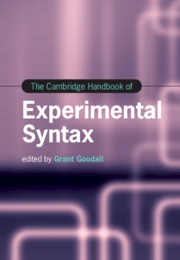Book contents
- The Cambridge Handbook of Experimental Syntax
- The Cambridge Handbook of Experimental Syntax
- Copyright page
- Contents
- Figures
- Tables
- Contributors
- Introduction
- Part I General Issues in Acceptability Experiments
- Part II Experimental Studies of Specific Phenomena
- Part III Experimental Studies of Specific Populations and Language Families
- 14 Acceptability Studies in L2 Populations
- 15 Judgments of Acceptability, Truth, and Felicity in Child Language
- 16 Acceptability and Truth-Value Judgment Studies in East Asian Languages
- 17 Acceptability Experiments in Romance Languages
- 18 Acceptability Studies in (Non-English) Germanic Languages
- 19 Acceptability Studies in Semitic Languages
- 20 Experimental Syntax and Slavic Languages
- 21 Acceptability Judgments in Sign Linguistics
- Part IV Experimental Syntax beyond Acceptability
- Index
- References
14 - Acceptability Studies in L2 Populations
from Part III - Experimental Studies of Specific Populations and Language Families
Published online by Cambridge University Press: 16 December 2021
- The Cambridge Handbook of Experimental Syntax
- The Cambridge Handbook of Experimental Syntax
- Copyright page
- Contents
- Figures
- Tables
- Contributors
- Introduction
- Part I General Issues in Acceptability Experiments
- Part II Experimental Studies of Specific Phenomena
- Part III Experimental Studies of Specific Populations and Language Families
- 14 Acceptability Studies in L2 Populations
- 15 Judgments of Acceptability, Truth, and Felicity in Child Language
- 16 Acceptability and Truth-Value Judgment Studies in East Asian Languages
- 17 Acceptability Experiments in Romance Languages
- 18 Acceptability Studies in (Non-English) Germanic Languages
- 19 Acceptability Studies in Semitic Languages
- 20 Experimental Syntax and Slavic Languages
- 21 Acceptability Judgments in Sign Linguistics
- Part IV Experimental Syntax beyond Acceptability
- Index
- References
Summary
This chapter discusses the use of acceptability judgment tasks in second language (L2) and bilingual populations. L2 studies that use AJTs can be divided into those that test a variety of phenomena, with the goal of investigating such issues as age effects and ultimate attainment, and those that focus on specific grammatical phenomena. Studies that use AJTs with L2 populations need to consider a number of issues, including task modality, time pressure, the use of context, the type of rating scale, and participants' reasons for accepting or rejecting a sentence. Finally, this chapter addresses the question of what AJTs measure with L2/bilingual populations, and whether AJTs run the risk of overestimating and/or underestimating L2 knowledge. Like any other tasks, AJTs have both advantages and disadvantages, and may best be used in conjunction with other types of data collection methodologies.
Keywords
Information
- Type
- Chapter
- Information
- The Cambridge Handbook of Experimental Syntax , pp. 373 - 393Publisher: Cambridge University PressPrint publication year: 2021
References
Accessibility standard: Unknown
Why this information is here
This section outlines the accessibility features of this content - including support for screen readers, full keyboard navigation and high-contrast display options. This may not be relevant for you.Accessibility Information
- 1
- Cited by
